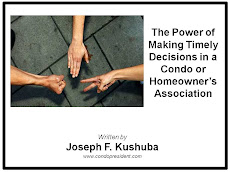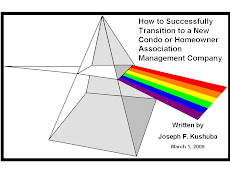
Clearly, the top function of a condo or homeowner BoD is to make good decisions that are best for the association and its members. When a BoD does not make good decisions, it can alienate its members, create distractions, and build mistrust towards the BoD. Decisions won’t stick - they will be revisited again, people will implement actions not chosen, or the results of the decision will be invisible in a matter of weeks. But, what does a good decision really look like?
There are two critical components; the quality of the decision and the timeliness of the decision.
• Quality of the decision. How would you recognize a high quality decision for your association if you saw one? Many would give answers like:
o All the right people have been involved
o We had all the best information available
o Risk was considered
o A decision was made—action occurred!
o Everybody bought in to the process
o The process did not drag on and on and loop around
o We did not get bogged down in the details
o There was a clear set of choices
o We knew about the difficult trade-offs to be made
o Implementation went smoothly
o Etc...
These are all important considerations among a long list of others. Generally, they can be summarized into six categories:
1. Is the right question being answered?
2. Have we generated a small set of creative yet feasible alternatives (or choices)?
3. Do we have meaningful and reliable information, particularly about risk?
4. Have we identified clear preferences and trade-offs?
5. Did we exercise sound reasoning, and clear communication about complex issues?
6. Do we have a commitment to action?
• Timeliness of the decision. The second component of good decision making is its timeliness. Nothing slows down an organization more than paralysis by analysis – the inability to make even smallest decisions quickly. Unnecessarily delaying a decision or making no decision is just the same as making a decision. You have simply chosen the option of taking no action. It means you are defaulting to the status quo.
When you don't make a timely decision, there are a lot of other bad things can happen, even though the decision itself may be a sound one. It can cause delays in decision implementation which in turn, can result in a missed opportunity or make a bad situation worse. It can put the association into a "downtime" condition that brings it to a temporary standstill on the issue being examined. It allows the grapevine and rumor mill to churn, which now brings further complications that have to be addressed. But, probably one of the biggest problems that it brings is a loss of confidence in the BoD leaders. Hesitation or a reluctance to make a decision is often the sign of ineffective leadership and is a surefire way for a BoD to lose support of its members and thus its ability to lead.
When it comes to decision making, successful BoD leaders have learned that action is vital. They live with the reality of consequences and know there will always be uncertainty in their decisions. No one can see all possible ramifications; no one can predict every contingency; no one can absolutely prevent failure. Strong leaders know that failure is not final, it is a learning opportunity. The real danger surrounding decision making is not "will I make the wrong decision" but "did I make the best decision possible given the facts and circumstances in a timely manner". Good leaders will always recover from poor decisions - they learn and become wiser. But weak leaders will mess around and miss opportunities. And once they finally make a decision, chances are their decision will have no momentum, no passion and no urgency and probably too late.








